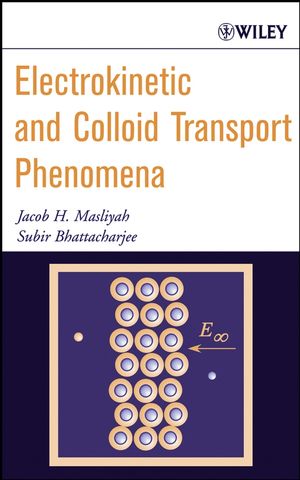Electrokinetic and Colloid Transport PhenomenaISBN: 978-0-471-78882-9
Hardcover
736 pages
June 2006
 This is a Print-on-Demand title. It will be printed specifically to fill your order. Please allow an additional 15-20 days delivery time. The book is not returnable.
|
||||||
COPYRIGHT ACKNOWLEDGMENTS.
CHAPTER 1 MATHEMATICAL PRELIMINARIES.
1.1 Units.
1.2 Physical Constants and Conversion Factors.
1.3 Frequently used Functions.
1.4 Vector Operations.
1.5 Tensor Operations.
1.6 Vector and Tensor Integral Theorems.
1.7 References.
CHAPTER 2 COLLOIDAL SYSTEMS.
2.1 The Colloidal State.
2.2 Colloidal Phenomena.
2.3 Stabilization of Colloids.
2.4 Preparation of Colloidal Systems.
2.5 Purification of Sols.
2.6 A Historical Summary.
2.7 Electrokinetic Phenomena in Modern Colloid Science.
2.8 Nomenclature.
2.9 References.
CHAPTER 3 ELECTROSTATICS.
3.1 Basic Electrostatics in Free Space.
3.2 Summary of Electrostatic Equations in Free Space.
3.3 Electrostatic Classification of Materials.
3.4 Basic Electrostatics in Dielectrics.
3.5 Boundary Conditions for Electrostatic Equations.
3.6 Maxwell Stress for a Linear Dielectric.
3.7 Maxwell’s Equations of Electromagnetism.
3.8 Nomenclature.
3.9 References.
CHAPTER 4 APPLICATION OF ELECTROSTATICS.
4.1 Two-Dimensional Dielectric Slab in an External Electric Field.
4.2 A Dielectric Sphere in an External Electric Field.
4.3 A Conducting Sphere in an External Electric Field.
4.4 Charged Disc and Two Parallel Discs in a Dielectric
Medium.
4.5 Point Charges in a Dielectric Medium.
4.6 Nomenclature.
4.7 Problems.
4.8 References.
CHAPTER 5 ELECTRIC DOUBLE LAYER.
5.1 Electric Double Layers at Charged Interfaces.
5.2 Potential for Planar Electric Double Layer.
5.3 Potential for Curved Electric Double Layer.
5.4 Electrostatic Interaction between Two Planar Surfaces.
5.5 Electrostatic Potential Energy.
5.6 Electrostatic Interactions between Curved Geometries.
5.6.1 The Derjaguin Approximation.
5.7 Models of Surface Potentials.
5.8 Zeta Potential.
5.9 Summary of Gouy–Chapman Model.
5.10 Nomenclature.
5.11 Problems.
5.12 References.
CHAPTER 6 FUNDAMENTAL TRANSPORT EQUATIONS.
6.1 Single-Component System.
6.2 Multicomponent Systems.
6.3 Hydrodynamics of Colloidal Systems.
6.4 Summary of Governing Equations.
6.5 Nomenclature.
6.6 Problems.
6.7 References.
CHAPTER 7 ELECTROKINETIC PHENOMENA.
7.1 Electroosmosis.
7.2 Streaming Potential.
7.3 Electrophoresis.
7.4 Sedimentation Potential.
7.5 Non-Equilibrium Processes and Onsager Relationships.
7.6 Nomenclature.
7.7 References.
CHAPTER 8 FLOW IN MICROCHANNELS.
8.1 Liquid Flow in Channels.
8.2 Electroosmotic Flow in a Slit Charged Microchannel.
8.3 Electroosmotic Flow in a Closed Slit Microchannel.
8.4 Effectiveness of Electroosmotic Flow.
8.5 Electric Current in Electroosmotic Flow in Slit Channels.
8.6 Streaming Potential in Slit Channels.
8.7 Electroviscous Flow in Slit Microchannels.
8.8 Electroosmotic flow in a Circular Charged Capillary.
8.9 High Surface Potential.
8.10 Surface Conductance.
8.11 Solute Dispersion in Microchannels.
8.12 Nomenclature.
8.13 Problems.
8.14 References.
CHAPTER 9 ELECTROPHORESIS.
9.1 Introduction.
9.2 Electrophoresis of a Single Charged Sphere.
9.3 Improved Solutions: Arbitrary Debye Length.
9.4 Electrophoretic Mobility in Concentrated Suspensions.
9.5 Circular Cylinders Normal to the Electric Field.
9.6 Nomenclature.
9.7 Problems.
9.8 References.
CHAPTER 10 SEDIMENTATION POTENTIAL.
10.1 Sedimentation of Uncharged Spherical Particles.
10.2 Concept of Sedimentation Potential and Velocity.
10.3 Dilute Suspensions: Ohshima’s Model.
10.4 Sedimentation Potential of Concentrated Suspensions.
10.5 Nomenclature.
10.6 Problems.
10.7 References.
CHAPTER 11 LONDON–VAN DERWAALS FORCES ANDTHE DLVOTHEORY.
11.1 Dispersion Forces Between Bodies in Vacuum.
11.2 Hamaker’s Approach.
11.3 Effects of Intervening Medium.
11.4 DLVO Theory of Colloidal Interactions.
11.5 Schulze–Hardy Rule.
11.6 Verification of the DLVO Theory.
11.7 Limitations of DLVO Theory.
11.8 Nomenclature.
11.9 Problems.
11.10 References.
CHAPTER 12 COAGULATION OF PARTICLES.
12.1 Introduction.
12.2 Dynamics of Coagulation.
12.3 Brownian Motion.
12.4 Collision Frequency.
12.5 Brownian Coagulation.
12.6 Coagulation due to Shear.
12.7 Nomenclature.
12.8 Problems.
12.9 References.
CHAPTER 13 DEPOSITION OF COLLOIDAL PARTICLES.
13.1 Introduction.
13.2 Classical Deposition Mechanisms.
13.3 Eulerian Approach.
13.4 Lagrangian Approach.
13.5 Deposition Efficiency and Sherwood Number.
13.6 Experimental Verifications.
13.7 Application of Deposition Theory.
13.8 Summary of Dimensionless Groups.
13.9 Nomenclature.
13.10 Problems.
13.11 References.
CHAPTER 14 NUMERICAL SIMULATION OF ELECTROKINETIC PHENOMENA.
14.1 Tools and Methods for Computer Based Simulations.
14.2 Numerical Solution of the Poisson–Boltzmann Equation.
.2.6 Validation of Numerical Results.
14.3 Flow of Electrolyte in a Charged Cylindrical Capillary.
in a Capillary Microchannel.
14.4 Analysis of Electrophoretic Mobility.
14.5 Concluding Remarks.
14.6 Nomenclature.
14.7 Problems.
14.8 References.
CHAPTER 15 ELECTROKINETIC APPLICATIONS.
15.1 Introduction.
15.2 Electrokinetic Salt Rejection in Porous Media and Membranes.
15.3 Electroosmotic Control of HazardousWastes.
15.4 Iontophoretic Delivery of Drugs.
15.5 Flotation of Oil Droplets and Fine Particles.
15.6 Rheology of Colloidal Suspensions.
15.7 Bitumen Extraction From Oil Sands.
15.8 Microfluidic and Nanofluidic Applications.
15.9 Nomenclature.
15.10 References.
INDEX.



